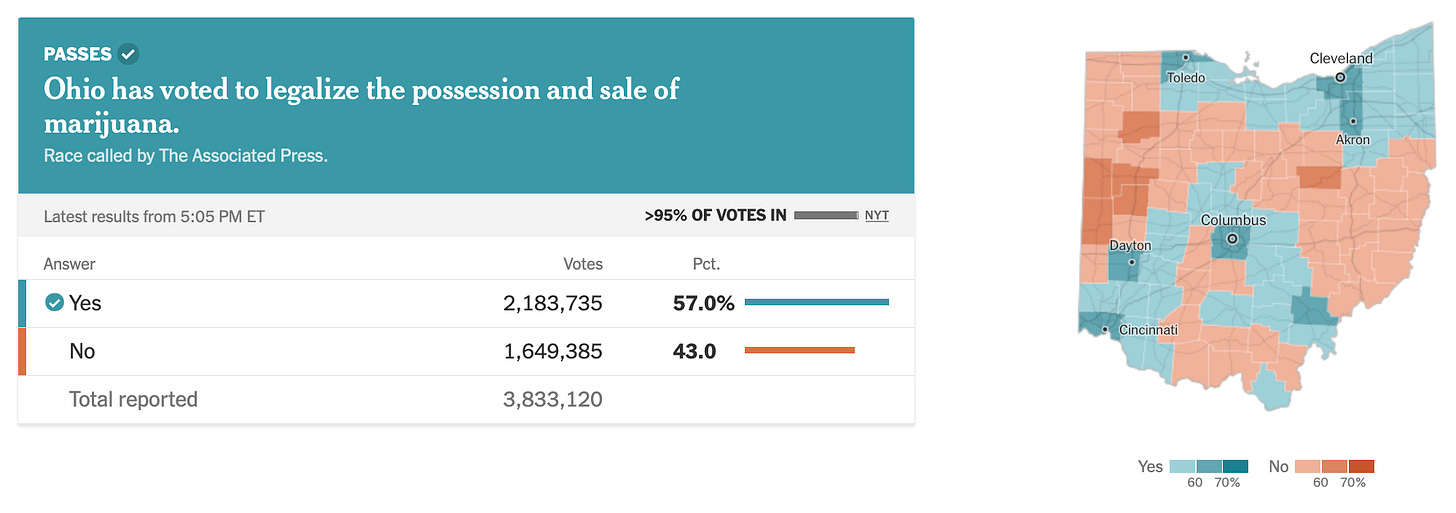Advice for newly-legalized states
Welcome to the party, Ohioans.
Yesterday, voters in Ohio approved a ballot measure to legalize non-medical use of cannabis. That means 53% of the U.S. population now have access to cannabis for recreational use.

When I was a cannabis regulator, I loved talking to officials in newly legalized states and countries to share advice and lessons learned. The conversations were surprisingly candid. When you’re one regulator talking to another, you can share what’s working, what’s not, and what you wish you could change in a way that you can’t when speaking to anyone who hasn’t carried the responsibility of implementation.
Ohio has experience regulating cannabis; they legalized medical use in 2016 and are active participants in the National Cannabis Regulators Association (CANNRA). Regulators will need to determine how to modify their current regulatory model, rather than learn how to regulate this industry anew.
In any case, here’s the advice that I used to give governments new to regulating cannabis:
1. Learn from others
When California legalized non-medical cannabis, there were only a handful of states that had already legalized, and most of them were only newly into implementation. There wasn’t a lot of long-term experience to draw from. That’s changed.
It’s now been more than a decade since Colorado and Washington first legalized non-medical cannabis. Regulators from 45 U.S. states and territories, and Canada, routinely share best practices through CANNRA. There is a lot of experience to learn from and a lot of people willing to share what they know.
2. Visit cannabis businesses
You can read and talk about cannabis policy, but there are some things that you can’t really understand until you’ve walked a facility and talked to the operators. Use your newfound relationships with regulators to set up tours of businesses operating legally in their states. Visit both compliant and non-compliant businesses. Ask a lot of questions.
In my experience, business owners are more than happy to share their approach, explain machinery and processes, answer your “dumb” questions, and tell you about the challenges that keep them up at night. Understanding how businesses are run is an undervalued trait in government. If you invest time to understand, they’ll take the time to educate you.
3. Help adults understand cannabis
We spend a lot of time talking about educating youth, but we don’t spend nearly enough time talking about how to educate adults. Many state legalization laws have come with a small pool of funding for education about what’s legal or not and driving under the influence. But we’re missing an opportunity for the type of responsibility messaging that could reduce long-term risks and help the nation avoid the type of unhealthy relationship that we currently have with alcohol.
Adults have more exposure than ever to cannabis, and they need guidance about how to be responsible consumers. Harm reduction messaging could help adults know what to expect, choose safer products, and store cannabis in a manner that prevent kids from getting access to it in the home.
4. Don’t overlook medical use
As more states legalize non-medical use of cannabis, regulator and business attention is turning away from medical use – sometimes to the detriment of patients. Products that medical patients value most are often not as commercially successful for recreational users, which represents a much larger slice of the market.
There aren’t many great examples of states that have continued to enhance their medical cannabis programs after non-medical legalization occurs. We all can do better in this area, so don’t lose sight of how and why cannabis was first legalized. Talk to patient advocates, including Americans for Safe Access. Talk to cannabis clinicians. Get your state’s medical board involved.

A word of caution
There was one terrible piece of advice that I remember hearing a lot when we first legalized (and still hear to this day). It went like this: “Regulate cannabis strictly to start, and then you can loosen rules later as you need.”
That is awful advice. Terrible, horrible, no good, very bad advice.
Government has a responsibility to protect consumers, the public, the environment, etc. But adding rules that you know are overly strict is not responsible. It’s creating a mess that someone else will have to clean up later1.
Here’s how I think about policy:
Everything has risks, and every rule you create costs money.
Businesses have to spend money to comply with rules, and the more rules you make, the more it costs to run the business. The more it costs to run a business, the higher the barriers will be for smaller businesses to enter the legal market or achieve success.
Government costs increase as the system gets more complicated, too, because more training and staffing are needed. It also makes it harder to set and communicate priorities (to staff and the public).
As a policymaker, you need to make sure you understand the actual versus perceived risks, so you don’t end up creating a bunch of costs that are disproportionate to the risk being mitigated.
We know a lot more today than we did in the mid 2010s about which rules are effective and which are not. Use this information, and don’t overthink it (or overregulate it).
If you’re a government official trying to figure out cannabis regulation, feel free to reach out: info@cannabispolicylab.com. We’re happy to share what we’ve learned, put you in touch with others, and point you to some great resources.
Anyone who has worked in government can tell you: rolling back rules is hard. There are entire Twitter accounts dedicated to pointing out old laws that make no sense, but no legislator or policymaker has the time, motivation or willingness to repeal or amend them.


